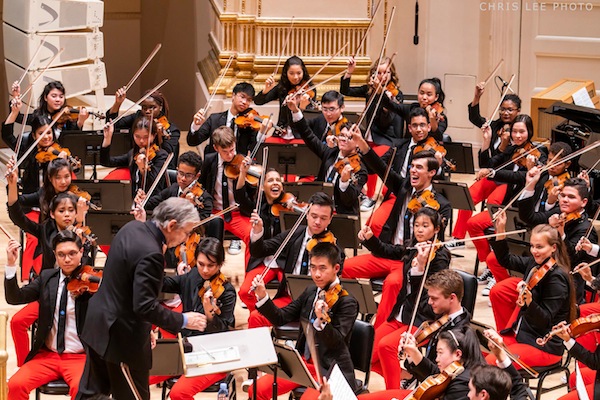National Youth Orchestra of USA brings fresh joy to music at Carnegie Hall

Michael Tilson Thomas conducted the National Youth Orchestra of the United States of America Thursday night at Carnegie Hall. Photo: Chris Lee
The National Youth Orchestra of the United States of America is not the New York Philharmonic, nor the Boston Symphony. As talented as these teenage musicians are, they’re not at the level of the world’s finest orchestras.
But that one thought of those other ensembles by way of comparison during the NYO-USA’s impassioned, compelling performance of Sibelius’s Symphony No. 2 at Carnegie Hall Thursday night is succinct tribute to how good this year’s orchestra is.
Their fifth straight annual visit to Carnegie had them under the baton of Michael Tilson Thomas–the perfect conductor for musicians in training–and joined by pianist Jean Yves Thibaudet, who played Gershwin’s Concerto in F.
The concert opened with the world premiere of Ted Hearne’s Brass Tacks. Hearne is one of the outstanding members of the young generation of contemporary composers, less generally known perhaps because of the blunt, two-fisted politics of much of his work. In that he is an heir to Fred Rzewski, as well as in style—though Hearne’s music sounds very different than Rzewski’s, his manner shares the same value of a plain, unfussy musical language and stripped-down eloquence.
Like so many of his peers–and probably like so many of the NYO-USA musicians–Hearne is fully immersed in American pop music, and it informs his own music making. Brass Tacks’ origin is in the “trap” style of southern hip hop. It’s not orchestral hip hop though—Hearne adapts some key concepts of rhythm and sonic embellishment from trap. The result is a finely crafted nine-note riff that could be both an effective bass line and a phrase from a Tchaikovsky ballet.
The music was full of interesting byways and surprising detours. Hearing the orchestra’s crisp performance of the ricocheting rhythms and spooky sonic visitations was like being a flanêur chancing upon essential details of environment that make city life worth living. The spaces and stretches of quiet in the music opened it up for intimate listening, like Central Park In The Dark updated for the era of personal listening devices.
Gershwin was the great urban composer, and his Concerto in F is the sound of a jaunty stroll down Fifth Avenue on a beautiful summer’s day. There’s also Gershwin’s poise and charm—he was the Fred Astaire of composers. Thibaudet sounded as sympathetic with this style as one would expect, playing with an energetic, un-exaggerated elegance and the kind of delight in the music that comes across as good-natured wit.
The orchestra’s accompaniment was as precise and sharp as the pianist’s playing, and there were some exceptional solo moments, especially the trumpet solo that opens the Adagio, which came from a player who seemed to be a young Harry James. This piece also showed, in an honest way, the orchestra’s youth—there were passages where the musicians didn’t seem to have any opinions about the notes they were playing, one way or another.
That fundamentally is what sets this group apart from the best orchestras. These are kids, yet to accumulate the kind of musical experiences through which they can develop a more individual sound, and the life experiences that make it both easier and more important to discover meaning in the notes they play.
And so both the concerto and the symphony, lacked that last bit of sonic and expressive color. That in no way kept the performance of Symphony No. 2 from stirring up both excitement and deep feeling. The orchestra had a big sound with the resonance Sibelius requires (the strings have added body to what has in the past been tremendous precision, perhaps due to this year’s conductor).
The complex and mysterious cross-rhythms of the Andante had a balance of freedom and precision—each group of instruments playing with exact and individual rubato—that was as fine and meaningful as one will ever hear in this piece. In the finale, the long, flowing minor key orchestral arpeggios that lead up to the awesome exhalation of D major built up a searing tension.
Tilson Thomas might have enjoyed the thrills of the orchestra’s playing more than anyone else. He had the musicians stand to accept the ovation before he himself turned toward the audience. Introducing the two encores, he praised the joy of the group’s playing.
First, the NYO-USA ripped through an athletic “Hoe-Down” from Rodeo, then the conductor moved to the side of the stage so the orchestra could handle the final encore by themselves. They set down their instruments, stood up, and performed Panda Chant No. II, one of Meredith Monk’s beautiful, exhilarating explorations of making music in the body—voice, stamping feet, coordinated movement—and there was more joy in that than has been heard on the New York concert scene in quite a long while.
The NYO2 (14-17 year olds) plays Revueltas, Prokofiev, and Shostakovich, with violinist Gil Shaham and conductor Carlos Miguel Prieto 7:30 p.m. Tuesday, July 24. carnegiehall.org